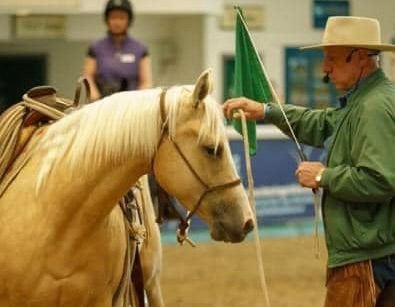Why A Flag?
Whether an older horse whom in some situations is uncertain or a young horse with little experience, a flag can help a hose to learn to handle stressful situations and let down; to become confident with motion and changing silhouettes, and can also help re-sensitise a horse that may have become dull to the handler.

Introducing the Horseman’s Flag to the Horse
We need to be mindful about how we introduce the flag to the horse, it’s not a case of just getting in there and making the horse accept the flag. The Horseman’s flag is an amazing training tool but for it to work for you, you need to be aware of it’s affect on the horse. You need to build the horse’s confidence to the flag.
You can start by having the material part of the flag tied to the pole so it is not flapping about if your horse takes exception to this. Start by facing the horse and walking backwards with the flag between yourself and the horse, encouraging the horse to follow. Following a ‘scary’ thing rather than having the ‘scary’ thing thrust towards you helps to improve confidence. Walk backwards in an arc to the left and to the right so the horse can see it out of both eyes. Allow the horse to close the distance between them and the flag so they can get closer as their confidence grows. Once the horse is confident following the flag, and sniffing the flag you can start to touch the horse with it.

Following on, begin to rub at the shoulder, lower neck and increase the area as the horse lets down and starts to relax. If he gets startled, try to stay with him and release (move the flag away), once he releases/lets down. Allow the horse some dwell time then go back to rubbing where he was happy to be rubbed. Then it’s about building on this using approach/retreat. In the beginning, and until the horse is confident with the flag around him, make sure you don’t go into those blind spots or too low down on the legs. The blind spots being underneath the jaw by the chest, front leg and right behind the horse. If you are in their blind spots it may cause the horse to strike out or kick in self defence. Also make sure that you use the flag on the side of the horse that you are on and not on the opposite side because if he gets startled he will most likely run right over you!

In the first instance when you are getting the horse to accept the flag, keep your body language neutral and soft. Some horses initially may want to move their feet to be ok with the flag but they can’t stand still and others will be acceptable to the flag when standing still but not in motion. So, if they can’t keep their feet still and need to move, allow this and drift with the horse and suggest the direction of movement, so you still have some control over the situation. If they get worried when you ask them to move their feet then go back to the approach/retreat - you many need to have a bigger bubble so don’t get too close to the horse with the flag.
Make sure you work on both sides of the horse. Some trainers like Martin will work on the right side first then go to the left as this will help to balance the horse so he is not so “left sided.” You usually get more reaction on the right side because most horses will have had their left side developed more.

Be mindful when using the flag, it is not to scare or spook the horse, used correctly it will build self confidence in your horse and have them understand motion to respond to verses motion to be confident with.

